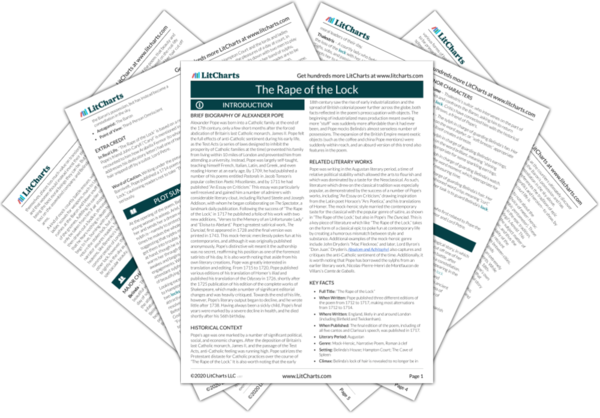Brief Biography of Alexander Pope
Alexander Pope was born into a Catholic family at the end of the 17th century, only a few short months after the forced abdication of Britain’s last Catholic monarch, James II. Pope felt the full effects of anti-Catholic sentiment during his early life, as the Test Acts (a series of laws designed to inhibit the prosperity of Catholic families at the time) prevented his family from living within 10 miles of London and prevented him from attending a university. Instead, Pope was largely self-taught, teaching himself French, Italian, Latin, and Greek, and even reading Homer at an early age. By 1709, he had published a number of his poems entitled Pastorals in Jacob Tonson’s popular collection Poetic Miscellanies, and by 1711 he had published “An Essay on Criticism.” This essay was particularly well received and gained him a number of admirers with considerable literary clout, including Richard Steele and Joseph Addison, with whom he began collaborating on The Spectator, a landmark daily publication. Following the success of “The Rape of the Lock,” in 1717 he published a folio of his work with two new additions, “Verses to the Memory of an Unfortunate Lady” and “Eloisa to Abelard.” Pope’s greatest satirical work, The Dunciad, first appeared in 1728 and the final version was printed in 1743. This mock-heroic mercilessly pokes fun at his contemporaries, and although it was originally published anonymously, Pope’s distinctive wit meant it the authorship was no secret, reaffirming his position as one of the foremost satirists of his day. It is also worth noting that aside from his own literary creations, Pope was greatly interested in translation and editing. From 1715 to 1720, Pope published various editions of his translation of Homer’s Iliad and published his translation of the Odyssey in 1726, shortly after the 1725 publication of his edition of the complete works of Shakespeare, which made a number of significant editorial changes and was heavily critiqued. Towards the end of his life, however, Pope’s literary output began to decline, and he wrote little after 1738. Having always been a sickly child, Pope’s final years were marked by a severe decline in health, and he died shortly after his 56th birthday.
Historical Context of The Rape of the Lock
Pope’s age was one marked by a number of significant political, social, and economic changes. After the deposition of Britain’s last Catholic monarch, James II, and the passage of the Test Acts, anti-Catholic feeling was running high. Pope satirizes the Protestant distaste for Catholic practices over the course of “The Rape of the Lock.” It is also worth noting that the early 18th century saw the rise of early industrialization and the spread of British colonial power further across the globe, both facts reflected in the poem’s preoccupation with objects. The beginning of industrialized mass production meant owning more “stuff” was suddenly more affordable than it had ever been, and Pope mocks Belinda’s almost senseless number of possessions. The expansion of the British Empire meant exotic objects (such as the coffee and china Pope mentions) were suddenly within reach, and an absurd version of this trend also features in the poem.
Other Books Related to The Rape of the Lock
Pope was writing in the Augustan literary period, a time of relative political stability which allowed the arts to flourish and which was dominated by a taste for the Neoclassical. As such, literature which drew on the classical tradition was especially popular, as demonstrated by the success of a number of Pope’s works, including “An Essay on Criticism,” drawing inspiration from the Latin poet Horace’s “Ars Poetica,” and his translations of Homer. The mock-heroic style married the contemporary taste for the classical with the popular genre of satire, as shown in “The Rape of the Lock,” but also in Pope’s
The Dunciad. This is a key piece of literature which like “The Rape of the Lock,” takes on the form of a classical epic to poke fun at contemporary life by creating a humorous mismatch between style and substance. Additional examples of the mock-heroic genre include John Dryden’s “Mac Flecknoe,” and later, Lord Byron’s “Don Juan.” Dryden’s
Absalom and Achitophel also captures and critiques the anti-Catholic sentiment of the time. Additionally, it is worth noting that Pope has borrowed the sylphs from an earlier literary work, Nicolas-Pierre-Henri de Montfaucon de Villars’s
Comte de Gabalis.
Key Facts about The Rape of the Lock
-
Full Title: “The Rape of the Lock”
-
When Written: Pope published three different editions of the poem from 1712 to 1717, making most alternations from 1712 to 1714.
-
Where Written: England, likely in and around London (including Binfield and Twickenham).
-
When Published: The final edition of the poem, including of all five cantos and Clarissa’s speech, was published in 1717.
-
Literary Period: Augustan
-
Genre: Mock-Heroic, Narrative Poem, Roman à clef
-
Setting: Belinda’s House; Hampton Court; The Cave of Spleen
-
Climax: Belinda’s lock of hair is revealed to no longer be in the Baron’s possession, but has instead become a constellation in the sky.
-
Antagonist: The Baron
-
Point of View: Third-Person Omniscient
Extra Credit for The Rape of the Lock
